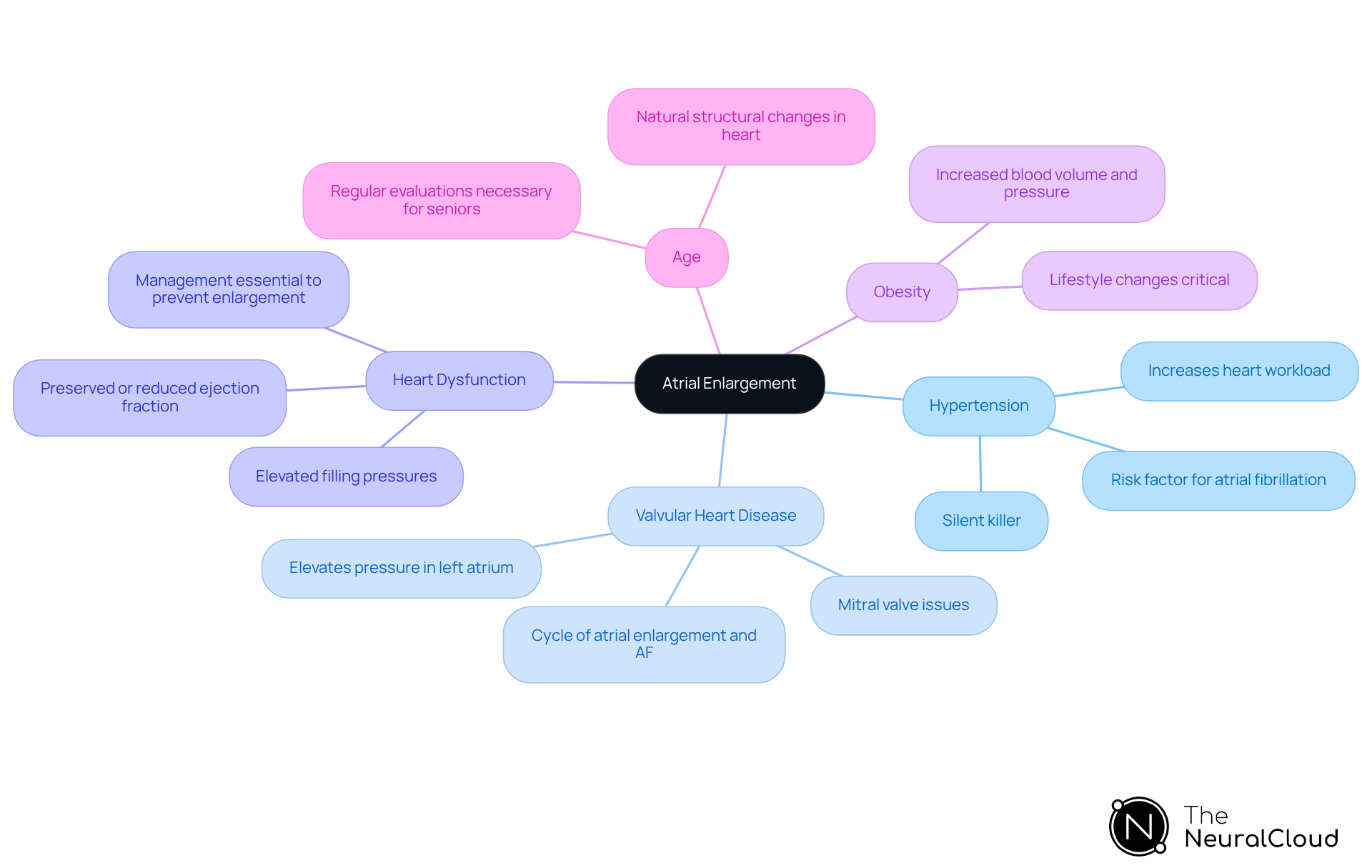Overview
Atrial enlargement primarily arises from underlying conditions such as:
- Hypertension
- Valvular heart disease
- Heart dysfunction
- Obesity
- Age
These factors lead to increased pressure or volume overload in the heart's atria. The clinical significance of atrial enlargement is emphasized, particularly its association with heightened risks of:
- Arrhythmias
- Stroke
- Heart failure
This underscores the critical importance of early detection and management strategies for patients affected by this condition.
Introduction
Atrial enlargement is a critical condition that can signify serious underlying health issues, often linked to hypertension, heart dysfunction, and age-related changes. Understanding its causes and clinical implications is essential for healthcare professionals, as it not only affects patient outcomes but also poses significant risks such as atrial fibrillation and stroke. The challenges in ECG analysis can complicate the detection and management of these risks.
However, with advancements in technology, the MaxYield™ platform offers innovative solutions to enhance the accuracy of ECG analysis. This platform provides clearer insights into cardiac health, enabling healthcare professionals to make informed decisions. Effectively utilizing these tools can significantly mitigate the risks associated with atrial enlargement and improve patient care.
Define Atrial Enlargement: Key Concepts and Clinical Significance
Atrial enlargement refers to an unusual increase in the size of one or both atria of the heart, typically resulting from various underlying conditions such as hypertension, cardiovascular disease, or physiological triggers like pregnancy and exercise. Clinically, it holds significance as it may indicate the presence of cardiovascular disease and is often associated with increased risks of arrhythmias, particularly atrial enlargement and atrial fibrillation (AF). Atrial enlargement can be detected through imaging methods like echocardiography and is characterized by changes in the electrical activity of the heart, which can be observed on an electrocardiogram (ECG).
The MaxYield™ platform from Neural Cloud Solutions addresses the challenges of ECG analysis by automating the labeling and extraction of ECG data. This advanced AI-powered technology allows for rapid beat-by-beat analysis of up to 200,000 heartbeats in less than five minutes. Key features of MaxYield™ include:
- Automation of ECG data labeling and extraction
- Rapid analysis of large datasets
- Improved precision in identifying heart chamber expansion
These features translate into significant advantages for healthcare professionals. By tackling issues such as physiological variability and signal artifacts prevalent in conventional ECG analysis, MaxYield™ enhances the accuracy of diagnostics. Additionally, it provides detailed outputs, including P-wave, QRS complex, and T-wave onsets and offsets, which are essential for identifying cardiac events.
Understanding atrial enlargement is crucial for cardiologists and healthcare professionals, as it indicates , including stroke and cardiac failure. The MaxYield™ platform supports confident clinical decision-making by delivering clear, actionable insights while contributing to cost reduction and operational efficiency in ECG analysis.

Identify Causes of Atrial Enlargement: Risk Factors and Pathophysiology
Atrial enlargement can occur due to several conditions that exert pressure or volume overload on the atria. Key contributors include:
- Hypertension: This significantly increases the heart's workload, leading to structural changes in the atria. Often referred to as the 'silent killer' due to its asymptomatic nature, hypertension poses a serious threat for developing heart chamber dilation and associated complications. Research indicates that hypertension is one of the most significant risk factors contributing to the onset of atrial fibrillation (AF), which can further complicate patient outcomes.
- Valvular heart disease: Including conditions such as mitral valve stenosis or regurgitation, elevates pressure in the left atrium, resulting in atrial enlargement. This relationship underscores the importance of regular monitoring and management of valvular issues to prevent further cardiac complications. Atrial fibrillation itself can both stem from and lead to atrial enlargement, creating a harmful cycle that complicates patient outcomes. Atrial fibrillation is particularly linked to a heightened likelihood of stroke, especially due to atrial enlargement in the left atrium.
- Heart dysfunction: Whether due to preserved or reduced ejection fraction failure, can lead to atrial enlargement as a result of elevated filling pressures. Effective management of heart failure is essential to reduce the likelihood of atrial enlargement and its associated complications.
- Obesity: Correlates with increased blood volume and pressure, which can lead to an increase in heart chamber size. Therefore, lifestyle changes, including weight control, are essential for minimizing this threat. Maintaining a healthy weight and normal blood pressure are critical preventive measures.
- Age: Is another factor, as growing older naturally raises the risk of atrial enlargement due to structural changes in the heart over time. Regular cardiovascular evaluations for seniors are necessary to monitor these changes.
Understanding these causes is vital for healthcare professionals to identify and implement appropriate interventions. Routine tests and echocardiograms are advised for tracking atrial enlargement, even in the absence of symptoms, to ensure prompt and efficient treatment. Notably, an Italian study discovered that 12% of adults experienced left chamber expansion over a 10-year span, particularly among individuals in their 40s and 50s, emphasizing the commonality of this condition.

Clinical Implications of Atrial Enlargement: Risks and Management
Atrial enlargement carries several significant clinical implications:
- Increased Risk of Atrial Fibrillation: Patients with atrial enlargement face a heightened risk of developing atrial fibrillation, a condition that can lead to serious complications, including stroke. Research indicates that left atrium expansion (LAE) serves as a significant predictor of heart rhythm disorders, with a hazard ratio of 3.32 for its identification in individuals with ischemic stroke.
- Heart Failure: The presence of chamber expansion often signifies declining cardiac function and may result in heart failure if not managed appropriately. Approximately 18.5% of patients with atrial enlargement also have a history of congestive heart failure, which highlights the necessity for vigilant monitoring and intervention.
- Stroke Hazard: Atrial enlargement is associated with an increased risk of stroke due to the potential for blood clot development in the atria. Studies show that moderate to severe atrial enlargement correlates with a 2.83-fold increased risk of recurrent cardioembolic or cryptogenic strokes, highlighting the importance of early detection and management.
- Management Strategies: Effective management of heart chamber expansion involves addressing underlying conditions such as hypertension and heart failure, along with regular monitoring for arrhythmias. Treatment options may encompass medications, lifestyle modifications, and, in certain cases, surgical interventions. The inclusion of exercise-focused cardiac rehabilitation has also been shown to aid in controlling heart rhythm disturbances, enhancing overall patient outcomes.
Understanding these implications is vital for healthcare providers to ensure timely and , ultimately improving their quality of care in cases of atrial enlargement.

Conclusion
Atrial enlargement is a significant cardiovascular condition that warrants careful attention due to its potential implications for heart health. This article has explored the multifaceted nature of atrial enlargement, highlighting its causes, clinical significance, and the advanced tools available for diagnosis and management. Understanding this condition is essential for healthcare professionals, as it serves as a key indicator of underlying cardiovascular issues that could lead to serious complications.
The article discussed various risk factors contributing to atrial enlargement, including:
- Hypertension
- Valvular heart disease
- Heart dysfunction
- Obesity
- Age
Each of these factors plays a critical role in the development of this condition and underscores the importance of regular monitoring and proactive management strategies. Furthermore, the implications of atrial enlargement, such as an increased risk of atrial fibrillation and stroke, emphasize the need for healthcare providers to remain vigilant in identifying and managing at-risk patients effectively.
In light of these insights, it is imperative for healthcare professionals to prioritize the early detection and management of atrial enlargement. By leveraging advanced technologies like the MaxYield™ platform, clinicians can enhance diagnostic accuracy and improve patient outcomes. The MaxYield™ platform provides precise ECG analysis, enabling healthcare professionals to identify atrial enlargement more effectively. This leads to timely interventions and better management of patients at risk.
Ultimately, a comprehensive understanding of atrial enlargement not only aids in clinical decision-making but also fosters a proactive approach to cardiovascular health. By ensuring that patients receive the care they need to mitigate risks, healthcare professionals can significantly improve their quality of life.
Frequently Asked Questions
What is atrial enlargement?
Atrial enlargement refers to an unusual increase in the size of one or both atria of the heart, often resulting from conditions such as hypertension, cardiovascular disease, or physiological triggers like pregnancy and exercise.
Why is atrial enlargement clinically significant?
Atrial enlargement is significant as it may indicate the presence of cardiovascular disease and is associated with increased risks of arrhythmias, particularly atrial fibrillation (AF).
How can atrial enlargement be detected?
Atrial enlargement can be detected through imaging methods like echocardiography and is characterized by changes in the heart's electrical activity, observable on an electrocardiogram (ECG).
What is the MaxYield™ platform?
The MaxYield™ platform from Neural Cloud Solutions is an AI-powered technology that automates the labeling and extraction of ECG data, enabling rapid beat-by-beat analysis of up to 200,000 heartbeats in less than five minutes.
What are the key features of the MaxYield™ platform?
Key features include automation of ECG data labeling and extraction, rapid analysis of large datasets, and improved precision in identifying heart chamber expansion.
How does MaxYield™ improve ECG analysis?
MaxYield™ enhances ECG analysis by addressing physiological variability and signal artifacts, leading to more accurate diagnostics and providing detailed outputs essential for identifying cardiac events.
Why is understanding atrial enlargement important for healthcare professionals?
Understanding atrial enlargement is crucial for cardiologists and healthcare professionals as it indicates potential cardiovascular issues, including stroke and cardiac failure.
How does the MaxYield™ platform support clinical decision-making?
The MaxYield™ platform supports clinical decision-making by delivering clear, actionable insights that contribute to cost reduction and operational efficiency in ECG analysis.






